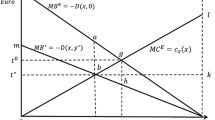Abstract
Self-protection has private goods characteristics as it reduces own exposure to pollution given a certain level of pollution. We study the effect of timing self-protection before, after or simultaneously with abatement. We find that self-protection when timed before abatements has strategic effects. In this case self-protection, shifts the second stage subgame perfect Nash equilibrium of abatements such that own contributions of abatement are decreased and those of the other country are increased. Thereby shifting future abatement costs to the other country. When countries cooperate only on abatement, the incentives to shift future abatement costs are greater. Contrary to, intention, cooperation on abatement may in fact worsen environmental quality if it does not include self-protection.
Similar content being viewed by others
References
Aggarwal RM, Narayan TA (2004) Does inequality lead to greater efficiency in the use of local commons? The role of strategic investments in capacity. J Environ Econ Manage 47: 163–182
Barrett S (1994) Self-enforcing international agreements. Oxf Econ Pap 46: 878–894
Baumol WJ, Oates WE (1988) The theory of environmental policy. Cambridge University Press, Cambrige
Buchholtz W, Konrad K (1994) Global environmental problems and strategic choice of technology. J Econ 60: 299–321
Copeland B, Taylor S (1990) Strategic enhancement and destruction of fisheries and the environment in the presence of international externalities. J Environ Econ Manage 19: 212–226
Dionne G, Eeckhoudt L (1985) Self-insurance, self-protection, and increased risk aversion. Econ Lett 17: 39–42
EEA (2005) Vulnerability and adaptation to climate change in Europe. Technical report 7/2005, EEA
Ehrlich I, Becker G (1972) Market insurance, self-insurance, and self-protection. J Polit Econ 80: 623–647
Fankhauser S, Smith J, Tol R (1999) Weathering climate change : some simple rules to guide adaptation decisions. Ecol Econ 30: 67–68
Immordino G (2003) Looking for a guide protect the environment: the development of the precautionary principle. J Econ Surv 17: 629–643
IPCC (2001) Climate change 2001: impact, adaptation and vulnerability. Cambridge University Press, Cambridge
Kane S, Shogren J (2000) Linking adaptation and mitigation in climate change policy. Clim Change 45: 75–102
Lewis T, Nickerson D (1989) Self-insurance against natural disaster. J Environ Econ Manage 16: 209–223
Mendelsohn R (2000) Efficient adaptation to climate change. Clim Change 45: 583–600
Ministery of Transport, Public Work and Water Management (2006) Spatial planning key decision room for the river. Rotterdam, 2006
Murdoch J, Thayer M (1990) The benefits of reducing the incidence of nonmelanoma skin cancer – a defensive expenditures approach. J Environ Econ Manage 18: 107–119
Parry M, Arnell N, Humle M, Nicholls R, Livermore M (1998) Adaptation to the inevitable. Nature 395: 741
Scheraga J, Grambsch A (1998) Risks, opportunities, and adaptation to climate change. Clim Res 10: 85–95
Shogren J, Crocker TD (1991) Cooperative and noncooperative protection against transferable and filterable externalities. Environ Resour Econ 1: 195–214
Smith J (1996) Climate change adaptation policy options. Clim Res 6(2): 193–201
Stranlund J (1996) On the strategic potential of technological aid in international environmental relations. J Econ 64: 1–22
Tol R (2005) Adaptation and mitigation: trade-offs in substance and methods. Environ Sci Policy 8: 572–578
Tol R, Frankhauser S, Smith J (1998) The scope for adaptation to climate change: what can we learn from the impact literature. Glob Environ Change 8(2): 109–123
UNDP (2004) Adaptation policy frameworks for climate change: developing strategies, policies and measures. Cambrige University Press, Cambrige
Wigley T (1997) Implications of recent co2 emission-limitation proposals for stabilization of atmospheric concentrations. Nature 390: 267–270
Author information
Authors and Affiliations
Corresponding author
Rights and permissions
About this article
Cite this article
Zehaie, F. The Timing and Strategic Role of Self-Protection. Environ Resource Econ 44, 337–350 (2009). https://doi.org/10.1007/s10640-009-9289-1
Received:
Accepted:
Published:
Issue Date:
DOI: https://doi.org/10.1007/s10640-009-9289-1




